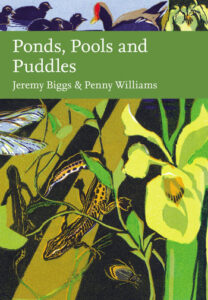 I’ve been collecting the volumes of the New Naturalist Library series for quite a number of years now. While my collection is no where near complete as I only began adding them to my library in 2005 or 2006, the main series has been ongoing since its inception in 1945 with E.B. Ford’s Butterflies being the inaugural volume. Then, of course, there is the challenge of my being in the U.S. and the books being published in the U.K. without U.S. distribution. Nevertheless, where there is a will, there is a way, and for me that way is the Natural History Book Store in Totnes, Devon, with whom I have long held a standing order for each new volume as it is published. As somewhere between one and three volumes are published each year, just about the time I finish reading the one that more recently arrived, a new one is on its way across the pond.
I’ve been collecting the volumes of the New Naturalist Library series for quite a number of years now. While my collection is no where near complete as I only began adding them to my library in 2005 or 2006, the main series has been ongoing since its inception in 1945 with E.B. Ford’s Butterflies being the inaugural volume. Then, of course, there is the challenge of my being in the U.S. and the books being published in the U.K. without U.S. distribution. Nevertheless, where there is a will, there is a way, and for me that way is the Natural History Book Store in Totnes, Devon, with whom I have long held a standing order for each new volume as it is published. As somewhere between one and three volumes are published each year, just about the time I finish reading the one that more recently arrived, a new one is on its way across the pond.
Not so very long ago, the new volume Ponds, Pools, and Puddles by Jeremy Biggs and Penny Williams found its way from Devon to my post box in Oregon. The 148th volume in the series, this most recently published volume takes, as I’m confident you could easily guess, as its subject the ecology of the smaller-than-lake sized bodies of fresh water as they appear in the U.K.
Now at this point I expect the question has formed in your mind “But you’re in the U.S. – why are you reading a book about ponds in the U.K.?” (I hear this often – or at least I expect I would if I had regular conversations with other naturalists… The good Rev. White have this sad state of existence very much in common) The answer is quite simple. First, because these volumes present natural history subjects at a level of quality of both content and style that is unmatched by any other ongoing series of natural history books in the English reading world. Second, because much of what each volume contains is, although written about the subject as it occurs in the U.K., by extrapolation applicable to a far larger geographic area than just those few islands. And third, because I dearly love British natural history both past and present, and unabashedly luxuriate in reading it.
Speaking of which, if you’ll now excuse me, I need to get reading. This particular volume is a tad longer than many others in the series and I want to be sure to complete my reading of it before Stoats, Weasels, Martens and Polecats by Jenny MacPherson makes it appearance in my post pox sometime in early August.
If you enjoyed reading this, please consider signing up for The Well-read Naturalist's newsletter. You'll receive a helpful list of recently published reviews, short essays, and notes about books in your e-mail inbox once each fortnight.
